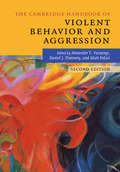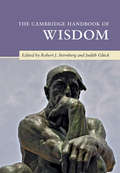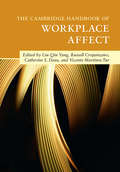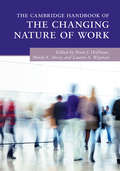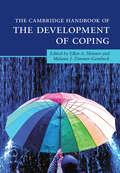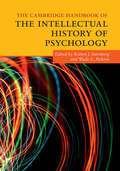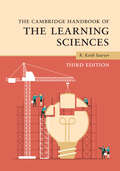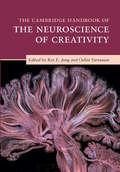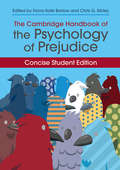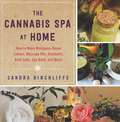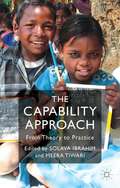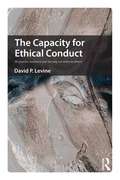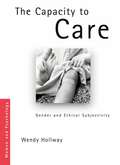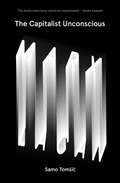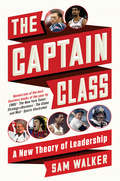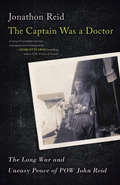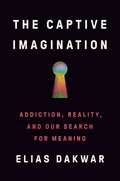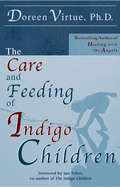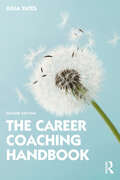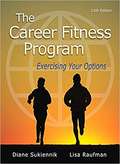- Table View
- List View
The Cambridge Handbook of Violent Behavior and Aggression (Cambridge Handbooks in Psychology)
by Daniel J. Flannery Alexander T. Vazsonyi Matt DeLisiThe Cambridge Handbook of Violent Behavior and Aggression presents the current state of knowledge related to the study of violent behaviors and aggression. An important extension of the first Handbook published ten years ago, the second edition maintains a distinctly cross-disciplinary focus by representing the newest scholarship and insights from behavior genetics, cross-cultural comparative psychology/criminology, evolutionary psychology, criminal justice, criminology, human development, molecular genetics, neurosciences, psychology, prevention and intervention sciences, psychiatry, psychopharmacology, public health, and sociology. The Handbook is divided into introductory and overview chapters on the study of violent behavior and aggression, followed by chapters on biosocial bases, individual and interpersonal factors, contextual factors, and prevention and intervention work and policy implications. It is an essential resource for researchers, scholars, and graduate students across social and behavioral science disciplines interested in the etiology, intervention, and prevention of violent behavior and aggression.
The Cambridge Handbook of Visuospatial Thinking
by Priti Shah Akira MiyakeVisuospatial thinking encompasses a wide range of thinking processes concerning space, whether it be navigating across town, understanding multimedia displays, reading an architectural blueprint or a map. Understanding it and in particular, how people represent and process visual and spatial information, is relevant not only to cognitive psychology but also education, geography, architecture, medicine, design, computer science/artificial intelligence, semiotics and animal cognition. This book presents a broad overview of research that can be applied to basic theoretical and applied/naturalistic contexts.
The Cambridge Handbook of Wisdom (Cambridge Handbooks in Psychology)
by Robert J. Sternberg Judith GlückThis is a comprehensive review of the psychological literature on wisdom by leading experts in the field. It covers the philosophical and sociocultural foundations of wisdom, and showcases the measurement and teaching of wisdom. The connection of wisdom to intelligence and personality is explained alongside its relationship with morality and ethics. It also explores the neurobiology of wisdom, its significance in medical decision-making, and wise leadership. How to develop wisdom is discussed and practical information is given about how to instil it in others. The book is accessible to a wide readership and includes virtually all of the major theories of wisdom, as well as the full range of research on wisdom as it is understood today. It takes both a basic-science and applied focus, making it useful to those seeking to understand wisdom scientifically, and to those who wish to apply their understanding of wisdom to their own work.
The Cambridge Handbook of Workplace Affect (Cambridge Handbooks in Psychology)
by Russell Cropanzano Liu-Qin Yang Catherine S. Daus Martínez-Tur VincenteAre you struggling to improve a hostile or uncomfortable environment at work, or interested in how such tension can arise? Experts in organizational psychology, management science, social psychology, and communication science show you how to implement interventions and programs to manage workplace emotion. The connection between workplace affect and relevant challenges in our society, such as diversity and technological changes, is undeniable; thus learning to harness that knowledge can revolutionize your performance in tackling workday issues. Applying major theoretical perspectives and research methodologies, this book outlines the concepts of display rules, emotional labor, work motivation, well-being, and discrete emotions. Understanding these ideas will show you how affect can promote team effectiveness, leadership, and conflict resolution. If you require a foundation for understanding workplace affect or a springboard into deeper, more interdisciplinary research, this book presents an integrative approach that is indispensable.
The Cambridge Handbook of the Changing Nature of Work (Cambridge Handbooks in Psychology)
by Brian J. Hoffman Mindy K. Shoss Lauren A. WegmanThis handbook provides an overview of the research on the changing nature of work and workers by marshalling interdisciplinary research to summarize the empirical evidence and provide documentation of what has actually changed. Connections are explored between the changing nature of work and macro-level trends in technological change, income inequality, global labor markets, labor unions, organizational forms, and skill polarization, among others. This edited volume also reviews evidence for changes in workers, including generational change (or lack thereof), that has accumulated across domains. Based on documented changes in work and worker behavior, the handbook derives implications for a range of management functions, such as selection, performance management, leadership, workplace ethics, and employee well-being. This evaluation of the extent of changes and their impact gives guidance on what best practices should be put in place to harness these developments to achieve success.
The Cambridge Handbook of the Development of Coping (Cambridge Handbooks in Psychology)
by Ellen A. Skinner Zimmer-Gembeck, Melanie J.Despite broad interest in how children and youth cope with stress and how others can support their coping, this is the first Handbook to consolidate the many theories and large bodies of research that contribute to the study of the development of coping. The Handbook's goal is field building - it brings together theory and research from across the spectrum of psychological, developmental, and related sciences to inform our understanding of coping and its development across the lifespan. Hence, it is of interest not only to psychologists, but also to neuroscientists, sociologists, and public health experts. Moreover, work on stress and coping touches many areas of applied social science, including prevention and intervention science, education, clinical practice, and youth development, making this Handbook a vital interdisciplinary resource for parents, teachers, clinical practitioners, social workers, and anyone interested in improving the lives of children.
The Cambridge Handbook of the Intellectual History of Psychology (Cambridge Handbooks in Psychology)
by Robert J. Sternberg Wade E. PickrenWe cannot understand contemporary psychology without first researching its history. Unlike other books on the history of psychology, which are chronologically ordered, this Handbook is organized topically. It covers the history of ideas in multiple areas of the field and reviews the intellectual history behind the major topics of investigation. The evolution of psychological ideas is described alongside an analysis of their surrounding context. Readers learn how eminent psychologists draw on the context of their time and place for ideas and practices, and also how innovation in psychology is an ongoing dialogue between past, present, and anticipated future.
The Cambridge Handbook of the Learning Sciences (Cambridge Handbooks in Psychology)
by R. Keith SawyerThe interdisciplinary field of the learning sciences encompasses educational psychology, cognitive science, computer science, and anthropology, among other disciplines. The Cambridge Handbook of the Learning Sciences, first published in 2006, is the definitive introduction to this innovative approach to teaching, learning, and educational technology. In this significantly revised third edition, leading scholars incorporate the latest research to provide seminal overviews of the field. This research is essential in developing effective innovations that enhance student learning - including how to write textbooks, design educational software, prepare effective teachers, and organize classrooms. The chapters illustrate the importance of creating productive learning environments both inside and outside school, including after school clubs, libraries, and museums. The Handbook has proven to be an essential resource for graduate students, researchers, consultants, software designers, and policy makers on a global scale.
The Cambridge Handbook of the Neuroscience of Creativity (Cambridge Handbooks in Psychology)
by Oshin Vartanian Rex E. JungHistorically, the brain bases of creativity have been of great interest to scholars and the public alike. However, recent technological innovations in the neurosciences, coupled with theoretical and methodological advances in creativity assessment, have enabled humans to gain unprecedented insights into the contributions of the brain to creative thought. This unique volume brings together contributions by the very best scholars to offer a comprehensive overview of cutting edge research on this important and fascinating topic. The chapters discuss creativity's relationship with intelligence, motivation, psychopathology and pharmacology, as well as the contributions of general psychological processes to creativity, such as attention, memory, imagination, and language. This book also includes specific and novel approaches to understanding creativity involving musicians, polymaths, animal models, and psychedelic experiences. The chapters are meant to give the reader a solid grasp of the diversity of approaches currently at play in this active and rapidly growing field of inquiry.
The Cambridge Handbook of the Psychology of Aesthetics and the Arts
by Pablo P. L. Tinio Jeffrey K. SmithThe psychology of aesthetics and the arts is dedicated to the study of our experiences of the visual arts, music, literature, film, performances, architecture and design; our experiences of beauty and ugliness; our preferences and dislikes; and our everyday perceptions of things in our world. The Cambridge Handbook of the Psychology of Aesthetics and the Arts is a foundational volume presenting an overview of the key concepts and theories of the discipline where readers can learn about the questions that are being asked and become acquainted with the perspectives and methodologies used to address them. The psychology of aesthetics and the arts is one of the oldest areas of psychology but it is also one of the fastest growing and most exciting areas. This is a comprehensive and authoritative handbook featuring essays from some of the most respected scholars in the field.
The Cambridge Handbook of the Psychology of Prejudice
by Barlow Sibley Chris G. Fiona KateThe Cambridge Handbook of the Psychology of Prejudice aims to answer the questions: why is prejudice so persistent? How does it affect people exposed to it? And what can we do about it? Providing a comprehensive examination of prejudice from its evolutionary beginnings and environmental influences through to its manifestations and consequences, this handbook is an essential resource for scholars and students who are passionate about understanding prejudice, social change, collective action, and prejudice reduction. Featuring cutting-edge research from top scholars in the field, the chapters provide an overview of psychological models of prejudice; investigate prejudice in specific domains such as race, religion, gender, and appearance; and develop explicit, evidence-based strategies for disrupting the processes that produce and maintain prejudice. This handbook challenges researchers and readers to move beyond their comfort zone, and sets the agenda for future avenues of research, policy, and intervention.
The Cambridge Handbook of the Psychology of Prejudice: Concise Student Edition (Cambridge Handbooks in Psychology)
by Fiona Kate Barlow Chris G. SibleyThe Cambridge Handbook of the Psychology of Prejudice: Concise Student Edition aims to answer the questions: why is prejudice so persistent? How does it affect people exposed to it? And what can we do about it? With cutting-edge research from top scholars in the field, the chapters present an overview of psychological models of prejudice and investigate key domains such as racism, sexism, and the criminal justice system. This student edition of the award-winning Handbook includes new pedagogical features such as learning objectives, core terms and definitions, summary points, discussion questions, recommended readings, and instructor's test bank. It also features a new conclusion chapter that analyzes eight hard problems currently faced by researchers and activists, thus engaging students in deep, forward-thinking discussion. Developed specifically for use in Psychology of Prejudice courses at the undergraduate and graduate levels, the Concise Student Edition is an essential teaching and learning resource.
The Cambridge Introduction to Performance Theory
by Simon ShepherdWhat does 'performance theory' really mean and why has it become so important across such a large number of disciplines, from art history to religious studies and architecture to geography? In this introduction Simon Shepherd explains the origins of performance theory, defines the terms and practices within the field and provides new insights into performance's wide range of definitions and uses. Offering an overview of the key figures, their theories and their impact, Shepherd provides a fresh approach to figures including Erving Goffman and Richard Schechner and ideas such as radical art practice, performance studies, radical scenarism and performativity. Essential reading for students, scholars and enthusiasts, this engaging account travels from universities into the streets and back again to examine performance in the context of political activists and teachers, countercultural experiments and feminist challenges, and ceremonies and demonstrations.
The Cannabis Spa at Home: How to Make Marijuana-Infused Lotions, Massage Oils, Ointments, Bath Salts, Spa Nosh, and More
by Sandra HinchliffeThe First Book to Bring Together Spa, Cannabis, and Herbal Healing The Cannabis Spa at Home contains more than seventy-five cannabis spa recipes free of preservatives and major allergens that can be prepared in the home kitchen or professional spa with wholesome herbal ingredients. Cannabis spa isn’t new--cannabis has been used for thousands of years for external use in the traditional health practices of Eastern cultures. In locations where cannabis has renewed legal status today, cannabis spa potions such as lotions, salves, poultices, scrubs, and baths are being rediscovered as a healthy alternative for managing pain, soothing irritated skin, and enhancing the spa experience. In The Cannabis Spa at Home, you’ll discover which spa preparations provide local healing--and which have potential for a more euphoric experience. You’ll also learn how to make: Refrigerated and shelf-stable cannabis lotions, creams, balms, and masks Emulsions, cannabis base oils, cannabis herbal poultices, aromatherapy essence water, cannabis bath salts, and foot and hand soaks Edible treats such as luscious spa nosh, hemp smoothies, and cannabis bhang
The Capability Approach
by Solava Ibrahim Meera TiwariHow can human capabilities be articulated and promoted in practice? How can the challenges encountered in its application be addressed? This volume answers these research questions through nine country case studies from the Global North and the Global South.
The Capacity for Ethical Conduct: On psychic existence and the way we relate to others
by David P. LevineWhat is the root cause of ethical failure? Why is preoccupation with ethics more a part of the problem than a part of the solution? What makes ethical conduct a natural expression of who we are? What enables us to be ourselves in our relations with others? Ethical failure has become a significant concern in public life, in organizations and in educational institutions. The Capacity for Ethical Conduct explores how qualities of character and personality either make ethical conduct possible for the individual or foster ethical failure. David Levine discusses how ethical conduct is a special way of relating to others, one that secures respect for their integrity by assuring that what they do can express who they are. He argues that this special way of relating to others results not from knowledge of, or a stated commitment to, rules, norms and values, but from the way we experience ourselves, especially from our ability to make a positive emotional investment in being and having a self. Traditionally, emphasis on the importance of values and ethics in shaping conduct tends to be connected to the need to find fault in self and others, fostering an atmosphere where the self is put at risk in its relations to others. This means that an excessive emphasis on ethics, rather than assuring ethical conduct, tends instead to create interpersonal settings marked by emotional assault. Because of this, talk about ethics often expresses ambivalence about ethical conduct, which makes the familiar combination of preoccupation with ethics and ethical failure unsurprising. The Capacity for Ethical Conduct explores the ways in which the interpersonal world of work either fosters a feeling of safety or encourages various forms of emotional assault. Presenting case studes and applying psychoanalytic object relation theory and self psychology, this book explores the factors underlying ethical failure and the capacity for ethical conduct. It will be of interest to scholars and practioners in the fields of psychoanalysis, psychology, philosophy, sociology, organizational dynamics, management and public administration.
The Capacity to Care: Gender and Ethical Subjectivity (Women and Psychology)
by Wendy HollwayWendy Hollway explores a subject that is largely absent from the topical literature on care. Humans are not born with a capacity to care, and this volume explores how this capacity is achieved through the experiences of primary care, gender development and later, parenting. In this book, the author addresses the assumption that the capacity to care is innate. She argues that key processes in the early development of babies and young children create the capability for individuals to care, with a focus on the role of intersubjective experience and parent-child relations. The Capacity to Care also explores the controversial belief that women are better at caring than men and questions whether this is likely to change with contemporary shifts in parenting and gender relations. Similarly, the sensitive domain of the quality of care and how to consider whether care has broken down are also debated, alongside a consideration of what constitutes a ‘good enough’ family. The Capacity to Care provides a unique theorization of the nature of selfhood, drawing on developmental and object relations psychoanalysis, as well as philosophical and feminist literatures. It will be of relevance to social scientists studying gender development, gender relations and the family as well as those interested in the ethics of care debate.
The Capitalist Unconscious
by Samo TomsicA major systematic study of the connection between Marx and Lacan's workDespite a resurgence of interest in Lacanian psychoanalysis, particularly in terms of the light it casts on capitalist ideology--as witnessed by the work of Slavoj i ek--there remain remarkably few systematic accounts of the role of Marx in Lacan's work. A major, comprehensive study of the connection between their work, The Capitalist Unconscious resituates Marx in the broader context of Lacan's teaching and insists on the capacity of psychoanalysis to reaffirm dialectical and materialist thought. Lacan's unorthodox reading of Marx refigured such crucial concepts as alienation, jouissance and the Freudian 'labour theory of the unconscious'. Tracing these developments, Tomšič maintains that psychoanalysis, structuralism and the critique of political economy participate in the same movement of thought; his book shows how to follow this movement through to some of its most important conclusions.From the Trade Paperback edition.
The Captain Class: A New Theory of Leadership
by Sam WalkerThe founding editor of The Wall Street Journal’s sports section profiles the greatest teams in history and identifies the counterintuitive leadership qualities of the unconventional men and women who drove them to succeed.The secret to winning is not what you think it is. It’s not the coach. It’s not the star. It’s not money. It’s not a strategy. It’s something else entirely. Several years ago, Sam Walker set out to answer one of the most hotly debated questions in sports: What are the greatest teams of all time? He devised a formula, then applied it to thousands of teams from leagues all over the world, from the NBA to the English Premier League to Olympic field hockey. When he was done, he had a list of the sixteen most dominant teams in history. At that point, he became obsessed with another, more complicated question: What did these freak teams have in common? As Walker dug into their stories, a pattern emerged: Each team had the same type of captain—a singular leader with an unconventional skill set who drove it to achieve sustained, historic greatness. Fueled by a lifetime of sports spectating, twenty years of reporting, and a decade of painstaking research, The Captain Class tells the surprising story of what makes teams exceptional. Drawing on original interviews with athletes from two dozen countries, as well as general managers, coaches, executives, and others skilled at building teams, Walker identifies the seven core qualities of this Captain Class—from extreme doggedness and emotional control to a knack for nonverbal communication to tactical aggression and the courage to stand apart. Told through riveting accounts of some of the most pressure-soaked moments in sports history—from Bill Russell’s legendary “Coleman Play” in the 1957 NBA Finals to Barcelona’s “Figo Game” against Real Madrid in 2000—The Captain Class doesn’t just bring these events to life; it presents a fresh, counterintuitive take on leadership that can be applied to a wide spectrum of competitive disciplines. The men and women who make up the Captain Class were never the most skilled athletes, nor were they gifted orators or paragons of sportsmanship. They were often role players who were allergic to the spotlight. In short, the seven attributes they shared challenge your assumptions of what inspired leadership looks like.Advance praise for The Captain Class“Well-researched, wildly entertaining, and thought-provoking. In The Captain Class, Sam Walker presents compelling narratives about the secret ingredient to the greatest teams of all time—and quickly makes you reexamine long-held beliefs about leadership and the glue that binds winning teams together.”—Theo Epstein, President of Baseball Operations for the Chicago Cubs“In The Captain Class, Sam Walker gives us important and original insights into the mysterious ingredients of transformative leadership. A stunning mix of research and narrative.”—Susan Cain, bestselling author of Quiet “If you care about leadership, talent development, or the art of competition, you need to read this immediately.”—Daniel Coyle, bestselling author of The Talent Code“The Captain Class is a brilliant hybrid: one-part detective story and one-part leadership book, set in the world of sports, and dedicated to a fascinating mystery: What sets apart the greatest teams of all time? I’m not even a sports nut and I couldn't put it down.”—Dan Heath, co-author of the New York Times bestseller Made to Stick
The Captain Was a Doctor: The Long War and Uneasy Peace of POW John Reid
by Jonathon ReidA Canadian medical officer and prisoner of war returns from the Second World War a hero — and a very different man. In August 1941, John Reid, a young Canadian doctor, volunteered to join the Royal Canadian Army Medical Corps with four friends from medical school. After five weeks of officer training in Ottawa, Reid took an optional two-week course in tropical medicine, a choice which sealed his fate. Assigned to “C” Force, the two Canadian battalions sent to reinforce “semi-tropical” Hong Kong, he was among those captured when the calamitous Battle of Hong Kong ended on Christmas Day. After a year in Hong Kong prison camps, Reid was chosen as the only officer to accompany 663 Canadian POWs sent to Japan to work as slave labourers. His efforts over the next two and a half years to lead, treat, and protect his men were heroic. He survived the war, but finding a peace of his own took ten tumultuous years, with casualties of a different sort. He would never be the same.
The Captive Imagination: Addiction, Reality, and Our Search for Meaning
by Elias DakwarA 2024 "NEXT BIG IDEA CLUB" MUST-READA profound, humane, and revolutionary new framework for understanding and addressing addiction. Addiction has been called a moral failing, a social problem, a spiritual crisis, a behavioral disorder, and a brain disease. It has also been called a class issue, a supply problem, a problem of learning, a memory disorder, and a result of trauma. And some propose that addiction is neither a disease nor a problem, but a transgressive expression of freedom, a maligned sub-culture, a therapeutic relationship. Even the term ‘addiction’ is open to question. There are few human phenomena so elusive and intractable; after decades of neuroscientific research, we aren’t much closer to understanding addiction, nor to addressing it effectively. This profusion of interpretations, meanings, and models reflects a hidden truth about addiction: that it is profusely generative of meaning itself. In this bold reimagining, pioneering psychiatrist Elias Dakwar examines addiction as a sustained creative act—and specifically as a process of personal world-building, complete with its own rituals, systems of value, modes of suffering, and sources of support. In this regard, addiction is something we all do. But there is a crucial difference. In the case of those of us suffering from addiction explicitly, this meaningful world keeps us in clear captivity, worsening the suffering and confusion we hoped it would console. And we remain stuck because we have trouble imagining it differently.Drawing on vivid stories of his own patients, path-breaking research with meditation, psychotherapy, and psychedelics/hallucinogens, and decades of clinical experience, Dakwar explores this captivity at the heart of our addictions, and shows how we might move beyond its bounds to reclaim our freedom. He also relates addiction to our collective self-inflicted crises, from environmental destruction to militarism to social injustice, rendering this often stigmatized condition relevant to all of us. With fluid, rich, and often startling prose, The Captive Imagination offers a novel path for better understanding and overcoming addiction, as well as human suffering more generally.
The Care and Feeding of Indigo Children
by Doreen VirtueIndigo Children are bright, intuitive, strong-willed, and sometimes self-destructive individuals. They are often labeled (and misdiagnosed) as having ADD or ADHD because they won't comply with established rules and patterns; and they may exhibit behavioral problems at home and at school. In The Care and Feeding of Indigo Children, Doreen Virtue explores the psyche of these special kids and offers alternative solutions to Ritalin based on her extensive research and interviews with child-care experts, teachers, parents, and the Indigo Children themselves. Read the accounts of these remarkable young people as they explain why they act-out, are aggressive or withdrawn; and what they want from the adults in their lives. You'll also be fascinated by the psychic experiences that these kids have had in their lives so far. This is a groundbreaking book that can positively affect the ways in which you interact with your children, altering the shape of their future in miraculous ways.
The Career Coaching Handbook
by Julia YatesUniquely combining the latest research into careers with the most up-to-date coaching approaches, Julia Yates shows how to effectively apply coaching techniques to the world of career support. Demonstrating how coaching research explains practice and how practice benefits from research, The Career Coaching Handbook is accessibly written with a solid evidence-based foundation. Presented in three parts, this new edition covers developments in theory and research and applies this knowledge to the real world, as well as introducing a few new practical approaches. Part 1, Theories of Career, looks at twenty-first century career paths, job satisfaction and career changes – both planned and unplanned. Part 2, Career Coaching Approaches, looks at coaching strategies that are applicable to career coaching in particular. Part 3, Coaching into the World of Work, covers specific real-world situations in which coaching is beneficial, from job search strategies to CV and interview coaching. Evidence and research is used throughout to demonstrate the most effective strategies for coaching. The Career Coaching Handbook provides an essential introduction for students or practitioners who are interested in developing their own practice, finding new and improved ways to do things and understanding the theories that underpin effective career coaching practice.
The Career Coaching Toolkit
by Julia YatesThe Career Coaching Toolkit is a practical guide to 34 effective and relevant career coaching techniques to help practitioners encourage, stretch and clarify their clients’ thinking. Structured around ten of the most common career dilemmas clients bring to their coaches, this book provides clear advice to coaches about when to apply the right technique to address all of these problems. With a dual focus on theory and practice, each chapter explores the links between the coaching technique and the scientific research on which it is based. The book explains how and why the technique works, giving the reader a real appreciation of the underlying mechanisms that make these techniques effective. Written specifically for career coaching, this deepened understanding will enhance confidence when working with clients. A practical toolkit for practitioners and students alike, The Career Coaching Toolkit will add depth to the practice of anyone working with clients facing a career crossroads, or conducting research into occupational identities and career decision making.
The Career Fitness Program: Exercising Your Options
by Diane Sukiennik Lisa RaufmanThe Career Fitness Program is firmly focused on today's career realities and economy – with sufficient breadth to encourage change and growth for learners of all ages, backgrounds, and circumstances. User-friendly, easy to read, and appropriate for all learners, it provides three teaching and learning career handles-choice, change, and confirmation-that help students find their career ‘fit’. For career choice, the book follows the standard sequence of career search and decision-making issues—Personal Assessment, World of Work, and Job Search. For career change, it offers critical questions thatgo beyond facts and figures to help learners focus on “What’s in it for me?” especially when changing careers. For career confirmation, it provides direction, understanding, and reassurance, showing learners how skills acquired in college are transferable to the world of work.
